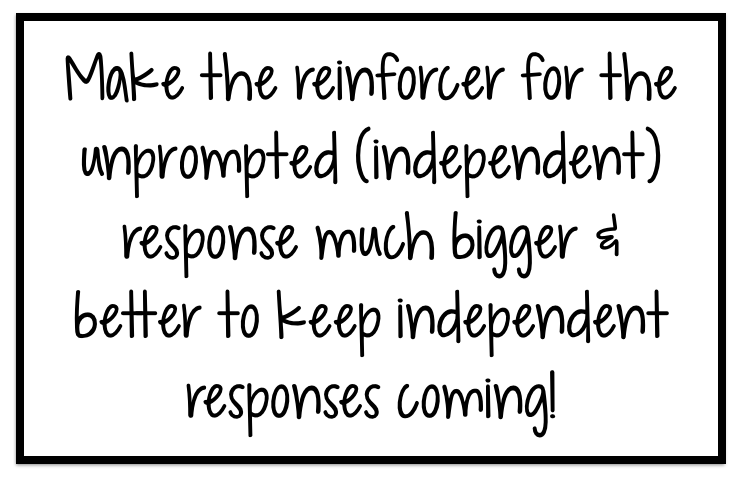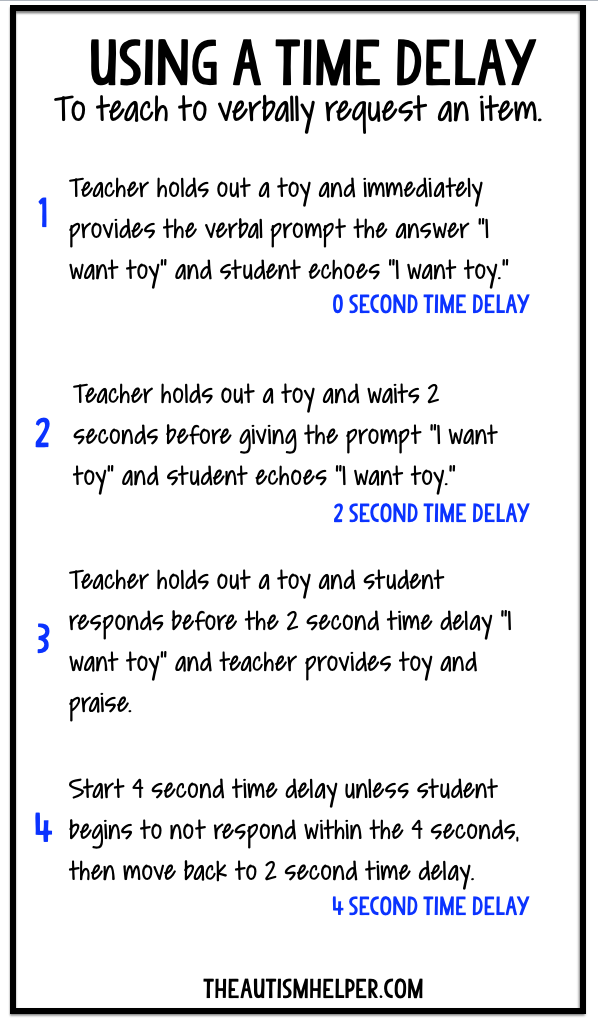Tag Archives: ASD
3 Ways To Fade Prompts
Super Sensory Sale!
Pick of the Week: Games!
Implementing the Intervention…Even When Things are Going Well
Recently I was working with a parent who was using a TimeTimer with her son to help him recognize when it was time to get ready for bed. Our plan was to start the timer every night while he was engaged in an activity, show him the timer and have him repeat how many minutes left, then have him tell his mom when the timer went off. For the first couple of weeks, this plan worked beautifully. The boy could see the time elapsing, brought the timer to his mother when it went off, and then started the process to get ready for bed without engaging in tantrum behaviors.
I went in for a parent training session after a month of the intervention and the boy’s mother informed me the timer just wasn’t working any more. As we started talking, I realized that the mother had drifted from our original plan in a way that is quite common. As her son experienced success, she used the timer less frequently. Then, if he was struggling, she would introduce the timer. In effect, she started only using the timer when he was misbehaving, instead of using it as a consistent tool to help him with the bedtime routine.
This type of procedural drift (when there is an unintentional or unplanned change in the procedure outlined for the intervention) is very common for parents, teachers, and ABA therapists. It’s important to understand this type of drift so it can be corrected when it occurs.
Here are a few things to remember when implementing an intervention:
• First, any intervention should include a clear plan for fading the intervention. In the example above, the TimeTimer was an appropriate tool for this particular child, who was only four years old. But we don’t want him to rely on the timer for the duration of childhood! A plan should include how to fade the intervention with specific steps and specific requirements for mastery.
• The use of the TimeTimer is considered an antecedent intervention. This means that we are implementing a change in the environment prior to any problem behaviors to help the child contact reinforcement and experience success. Antecedent interventions should be implemented consistently as part of a routine, not ONLY when a problem behavior occurs. If it is only implemented when the problem behavior occurs, it is no longer an antecedent intervention.
• If we implement a tool (like the TimeTimer) only when problem behavior occurs, it’s possible the tool will become aversive to the child and possibly result in an increased magnitude of the problem behavior.
• Consider using tools for the people implementing to intervention to remind them of the specific steps. For example, you might create a video model and instruct the parent (or other adult implementing the intervention) to watch it every couple days. Or you might post the steps in a clear space to be reviewed regularly.
• Finally, we have to remember that a couple of good days in a row without any instances of problem behavior does not mean that the problem is solved. This is why the first step outlined above is so important. We want to teach the child replacement behaviors and give them lots of opportunities to be successful with it.
Ultimately, we were able to re-implement the procedure with this parent and see more continued success with this particular case. We also decided to post the steps to the intervention on the back of the TimeTimer for easy review on a daily basis.
However, in some cases, you might have to create an entirely new intervention using different tools. The goal is to be clear about the steps of the intervention, and to maintain those steps when implementing the intervention.
WRITTEN BY SAM BLANCO, PhD, LBA, BCBA
Sam is an ABA provider for students ages 3-15 in NYC. Working in education for twelve years with students with Autism Spectrum Disorders and other developmental delays, Sam utilizes strategies for achieving a multitude of academic, behavior, and social goals. She is also an assistant professor in the ABA program at The Sage Colleges.
How Parents Can Fit ABA Into Their Busy Schedules
“Dear Behavior BFF, I have followed your posts for a while now. The problem I see is that in order for me to be successful as a parent, I have to follow ABA 100% of the time. In order to be effective, do I need to enroll in graduate classes and learn everything I can about ABA? Do I need to become a BCBA to manage my own kids’ behavior better? Feeling overwhelmed over here…”
Thank you for learning about ABA as a parent. The science of behavior can help us SO much with our own kids. But does that mean you need to know every technical definition and fact before you can use some behavior strategies in your own home? NO! Heck no!
You are a busy parent. I am a busy parent. Most people reading this are busy parents (at least that’s the intended audience). Do you have time to complete a master’s degree in behavior analysis just to help you be a more efficient parent who capitalizes on the science of behavior? Ummm…no. You don’t have that kind of time. So does that mean you should give up on using behavior analysis as a parent? Also no.
Behavior analysis teaches us to focus on the behavior itself. It teaches us to manipulate the environment to help our kids engage in desired and proactive behaviors. It helps us find ways to increase positive reinforcement, increase positive interactions, and teach our kids to effectively communicate their wants and needs.
The good news is we can do all of those things within the constraints of our busy family schedules! You can use positive reinforcement effectively without knowing the difference between differential reinforcement of incompatible or alternative behaviors.
And more good news: when you need to get technical, there are Board Certified Behavior Analysts (BCBAs) to do that with you! We like talking behavior science. We are ABA nerds. Let us do that part for you. If you want to join us, then enroll in that ABA graduate program. If you don’t want a new career- then learn what you can as a parent in the time that you have.
So where do you start in order to not be overwhelmed and get the benefit of decades of behavioral research? You’re in the right place. Peruse these non-academic articles offered at bSci21 that help make the science easier to digest. Learn about positive reinforcement and how to use it effectively.
Start by providing positive reinforcement for desired behaviors. Decide what you want your child to do more of, then reward them for doing it! Start small with one behavior strategy at a time, then continue to learn and add another positive behavior support as you go.
You don’t have to become a behavior expert in order to effectively use behavior analysis to save your sanity as a parent. Start small, build a little at a time. Celebrate your successes. Reward your child(ren) for their successes. Shape your own behavior by building on with baby steps. Every step in the right direction is a success. Make it work for you and your family in the time that you have. You CAN do this!
About The Author
Leanne Page, MEd, BCBA, is the author of Parenting with Science: Behavior Analysis Saves Mom’s Sanity. As a Behavior Analyst and a mom of two little girls, she wanted to share behavior analysis with a population who could really use it- parents!
Leanne’s writing can be found in Parenting with Science and Parenting with ABA as well as a few other sites. She is a monthly contributor to bSci21.com , guest host for the Dr. Kim Live show, and has contributed to other websites as well.
Leanne has worked with children with disabilities for over 10 years. She earned both her Bachelor’s and Master’s degrees from Texas A&M University. She also completed ABA coursework through the University of North Texas before earning her BCBA certification in 2011. Leanne has worked as a special educator of both elementary and high school self-contained, inclusion, general education, and resource settings.
Leanne also has managed a center providing ABA services to children in 1:1 and small group settings. She has extensive experience in school and teacher training, therapist training, parent training, and providing direct services to children and families in a center-based or in-home therapy setting.
Leanne is now located in Dallas, Texas and is available for: distance BCBA and BCaBA supervision, parent training, speaking opportunities, and consultation. She can be reached via Facebook or at Lpagebcba@gmail.com.
ABA Essentials Sale: Token Economies!
Qualifications of Practitioners/Consultants who Practice ABA
This month’s ASAT feature comes to us from Sabrina Freeman, PhD, ASAT’s Consumer Corner Coordinator. To learn more about ASAT, please visit their website at www.asatonline.org. You can also sign up for ASAT’s free newsletter, Science in Autism Treatment, and like them on Facebook!
It’s crucial to be a savvy consumer when it comes to one of the most important decisions you will make for your loved one with autism – choosing an ABA treatment provider for your child. Those of us who have already walked in your shoes know that all treatment providers are not the same. To the uninitiated, these professionals all look marvelous. From the slick websites, to the large numbers of associations of which these professionals are members, it is becoming increasingly difficult to differentiate between mediocre and outstanding treatment providers. Furthermore, publication of research in high quality journals is not synonymous with clinical expertise.
Fortunately, in this issue of Consumer Corner, we present a summary of consumer guidelines created by the Autism Special Interest Group (SIG) of the Association of Behavior Analysis International to help you make an informed choice when searching for ABA professionals to design, run and maintain your child’s program. A complete copy of the SIG guidelines are available here: https://3lvvdfmmeol12qpvw2c75ch6-wpengine.netdna-ssl.com/wp-content/uploads/2018/07/Final-Autism-Sig-Guidelines-Parent-Version-May-2018.pdf It is important to remember that your child’s future depends on highly quality consulting. Good luck!
- Certification:
Treatment professionals must all have advanced degrees, e.g., a Master’s Degree or a Doctorate in a relevant field of study, and be certified either by the Behavior Analyst Certification Board (BACB), or a board that has equal or higher level requirements than the BACB. To look up your consultant, visit: www.bacb.com and click on “Find A Certificant.” If the potential consultant is not on this list, ask where he/she became credentialed, and trained so that you can verify licensure and experience to determine whether it is equal to/or surpasses the standards of the BACB. If this individual responds to your inquiry in a defensive manner, then you may consider looking elsewhere as you are well within your right to seek clarification about certification status.
- Extensive Hands-On Supervised Training:
Consultants are required to have extensive hands-on training treating children with autism in which they have worked at least one full year (1500 clock independent supervised hours or 1000 hours if taking a university practicum and 750 hours if taking an intensive practicum) under the supervision of a credentialed BCBA Certificant. In addition, they need to prove competency in many areas that cover the design and implementation of both individualized ABA interventions, and comprehensive ABA treatment programs. The partial list below was created by the Autism Special Interest Group (SIG) below. Your consultant should be competent in all the following areas:
- a) Design and implement individualized ABA Interventions
- community living skills
- functional communication skills (vocal and non-vocal)
- “learning to learn” skills (e.g., looking, listening, following instructions, imitating)
- motor skills
- personal safety skills
- play and leisure skills
- pre-academic and academic skills
- reduction of behaviors that jeopardize health and safety and impede successful functioning (e.g., stereotypic, obsessive, ritualistic, aggressive, self-injurious, disruptive, and other behaviors often described as “challenging”).
- school readiness skills
- self-care skills
- self- management skills
- social interaction skills
- vocational
- b) Design and implement both comprehensive ABA intervention programs (using multiple ABA procedures to address multiple intervention targets) and focused interventions (using one or more ABA procedures to address a small number of intervention targets).
- c) Delivering ABA interventions directly to at least 8 individuals with autism who present with a range of repertoires, levels of functioning, and ages.
- d) Implementing the full range of scientifically validated behavior analytic procedures, including but not limited to:
- reinforcement (including differential reinforcement)
- extinction
- discrete-trial procedures
- modeling (including video modeling)
- incidental teaching and other “naturalistic” methods
- activity-embedded intervention
- task analysis
- chaining
- activity schedules
- scripts and script fading
- prompting and prompt-fading
- errorless training
- error correction
- motivating operations
- stimulus control
- preference assessments
- choice
- augmentative and alternative communication training procedures.
- Continuing Education:
Not only do behavioral consultants need to be trained as above, in order to maintain their certification, practitioners must also pursue continuing education in a variety of areas that may include, but are not limited to, Applied Behavior Analysis.
Red Flag
These practitioners should not be working collaboratively with professionals who implement an eclectic mix of interventions that are untested, discredited or experimental in nature. If the consultant you use endorses an eclectic approach, understand that this practice is inconsistent with the BACB Guidelines for Responsible Conduct for Behavior Analysis. This red flag is a particularly helpful way to be forewarned about a consultant who is not a good choice to design and maintain your child’s program!
Common Mistakes In Implementing Reinforcement
Over the years, I’ve seen several behavior intervention plans written and implemented. Typically, these plans include reinforcement for the desirable behavior, but I see the same mistakes crop up again and again. Here are a few common mistakes in implementing reinforcement to look out for:
Fail to identify individual reinforcers. Hands down, the most common error I see is identifying specific activities or items as reinforcing. For instance, many people love gummy bears, but they make me want to puke. Presenting me with a gummy bear would not increase my future likelihood of engaging in the appropriate behavior! You must account for individual differences and conduct a preference assessment of your learner, then make a plan based on his or her preferences.
Fade reinforcement too quickly. Let’s say you’re working with a child named Harold who draws on the walls with crayon. You implement a reinforcement plan in which he earns praise and attention from his parent each time he draws on paper. The first few days it’s implemented, Harold’s rate of drawing on the wall greatly decreases. Everyone claims that his behavior is “fixed” and suddenly the plan for reinforcement is removed… and Harold begins drawing on the wall once more. I see this sort of pattern frequently (and have even caught myself doing it from time to time). After all, it can be easy to forget to reinforce positive behavior. To address this issue, make a clear plan for fading reinforcement, and use tools such as the MotivAider to help remind you to provide reinforcement for appropriate behavior.
Inconsistent with reinforcement plan. Harriet is writing consistently in a notebook, to the detriment of her interactions with peers. Her teachers implement a DRO, deciding to provide reinforcement for behavior other than the writing. However, the teachers didn’t notify all the adults working with her of the new plan, so Harriet’s behavior persists in certain environments, such as at recess, allowing her to miss multiple opportunities for more appropriate social interaction. To address this issue, make a clear outline of the environments in which the behavior is occurring and what adults are working in those environments. Ensure that all of the adults on that list are fully aware of the plan and kept abreast of any changes.
Don’t reinforce quickly enough. This one can be quite challenging, depending on the behavior and the environment. Let’s saying you’re working with a boy named Huck who curses often. You and your team devise a plan to reinforce appropriate language. You decide to offer him tokens that add up to free time at the end of the school day. However, sometimes as you are handing him a token for appropriate language, he curses again right before the token lands in his hand. Though it was unintentional, the cursing was actually reinforced here. Remember that reinforcement should be delivered as close to the desired behavior as possible. To address this issue, consider your environment and materials and make a plan to increase the speed of delivery.
Fail to make a plan to transfer to natural reinforcers. Ultimately, you don’t want any of these behaviors to change based solely on contrived reinforcement. Making a plan for reinforcement of appropriate behavior is essential, but your ultimate goal is to have the behavior be maintained by naturally occurring reinforcement. To address this issue, the first thing you need to do is identify what that naturally occurring reinforcement might be. For Harold, it might be having his artwork put up in a special place or sharing it with a show and tell. For Harriet it might be the interactions she has with peers on the playground. Once you have identified those reinforcers, you can create a plan for ensuring that the learner contacts those reinforcers over time. This might include pairing the naturally occurring reinforcers with the contrived reinforcers, then fading out the latter.
Ultimately, it’s important to remember that reinforcement is not as simple as it seems. Taking the time to plan on the front end will help with long-term outcomes.
WRITTEN BY SAM BLANCO, PhD, LBA, BCBA
Sam is an ABA provider for students ages 3-15 in NYC. Working in education for twelve years with students with Autism Spectrum Disorders and other developmental delays, Sam utilizes strategies for achieving a multitude of academic, behavior, and social goals. She is also an assistant professor in the ABA program at The Sage Colleges.
How To Prepare To Reinforce Appropriate Behavior
Often when we’re working with children with autism there are two areas we focus on: communication and play. However, due to the nature of your day or a specific activity, you may unintentionally punish spontaneous communication or play. So before we learn how to prepare to reinforce appropriate behavior, let’s consider a couple of examples:
Julie is a teacher in a first grade classroom with six children with autism. One of her students is Marcos, who rarely uses spontaneous language. While Julie is running the morning meeting, Marcos suddenly interrupts and says “I like elephants.” Julie says, “It’s quiet time, right now, Marcos.”
David is a teacher in a fourth grade inclusion classroom. Jaylene is a student with autism who rarely initiates interactions. He is speaking with another teacher when Jaylene approaches with a puppet, hands it to David, and says “puppet.” David tells her, “In just a minute, Jaylene.”
In both of these instances, the teacher has not done anything wrong. In fact, we have all done this from time to time in the midst of busy days in which we’re managing multiple tasks. But there’s an argument to be made here that both Marcos and Jaylene missed opportunities for reinforcement of the behaviors we most want them to exhibit.
One thing that can help is to prioritize your goals. If the primary goal for Marcos is to use spontaneous language, then when we start out we want to provide a continuous rate of reinforcement. This means that it will sometimes interrupt other tasks, but if it is the biggest priority, that’s okay! The long term gains of reinforcing Marcos’s spontaneous language likely outweigh the frustration of an interrupted lesson.
The second thing that can help is communicating the priorities to other adults and staff. If David lets other teachers and administrators know that Jaylene’s foremost goal is to initiate interactions related to play, then a brief interruption in a conversation should not be an issue. Again, the long term gains of reinforcing Jaylene’s initiation of play likely outweigh any issues around an interrupted conversation.
Finally, try to plan ahead. Think about instances in which the child is most likely to engage in the targeted behaviors and talk with staff about how to ensure reinforcement takes place. The last thing we want to do is to unintentionally punish the desired behaviors.
WRITTEN BY SAM BLANCO, PhD, LBA, BCBA
Sam is an ABA provider for students ages 3-15 in NYC. Working in education for twelve years with students with Autism Spectrum Disorders and other developmental delays, Sam utilizes strategies for achieving a multitude of academic, behavior, and social goals. She is also an assistant professor in the ABA program at The Sage Colleges.








